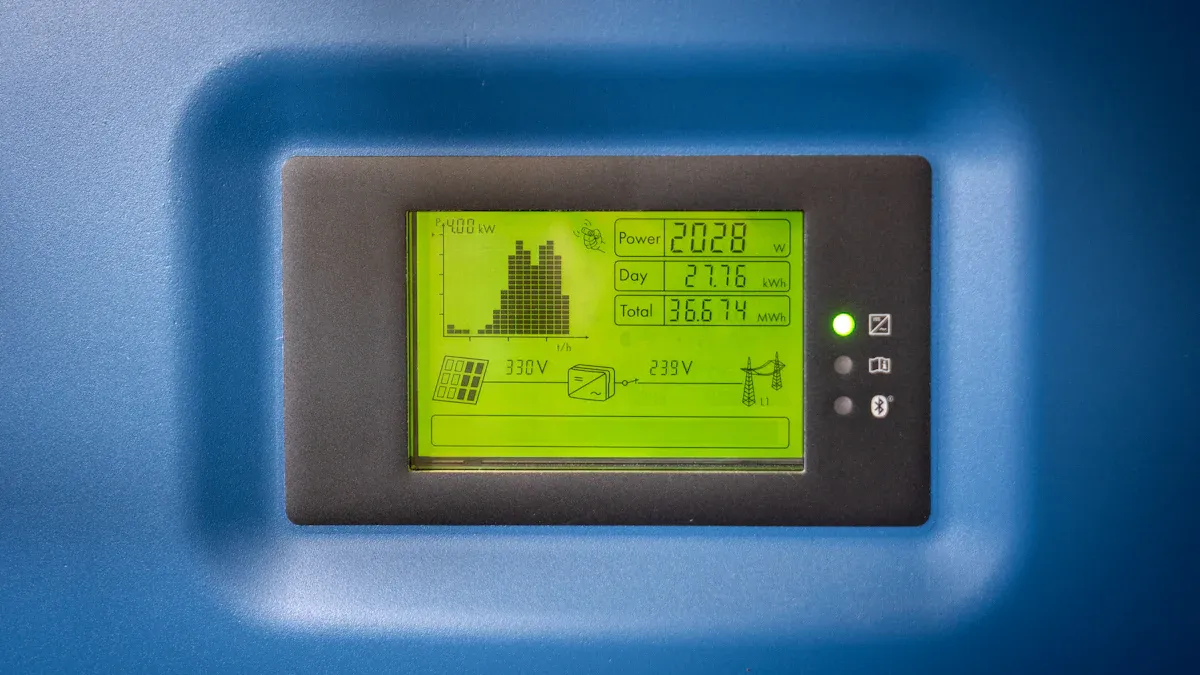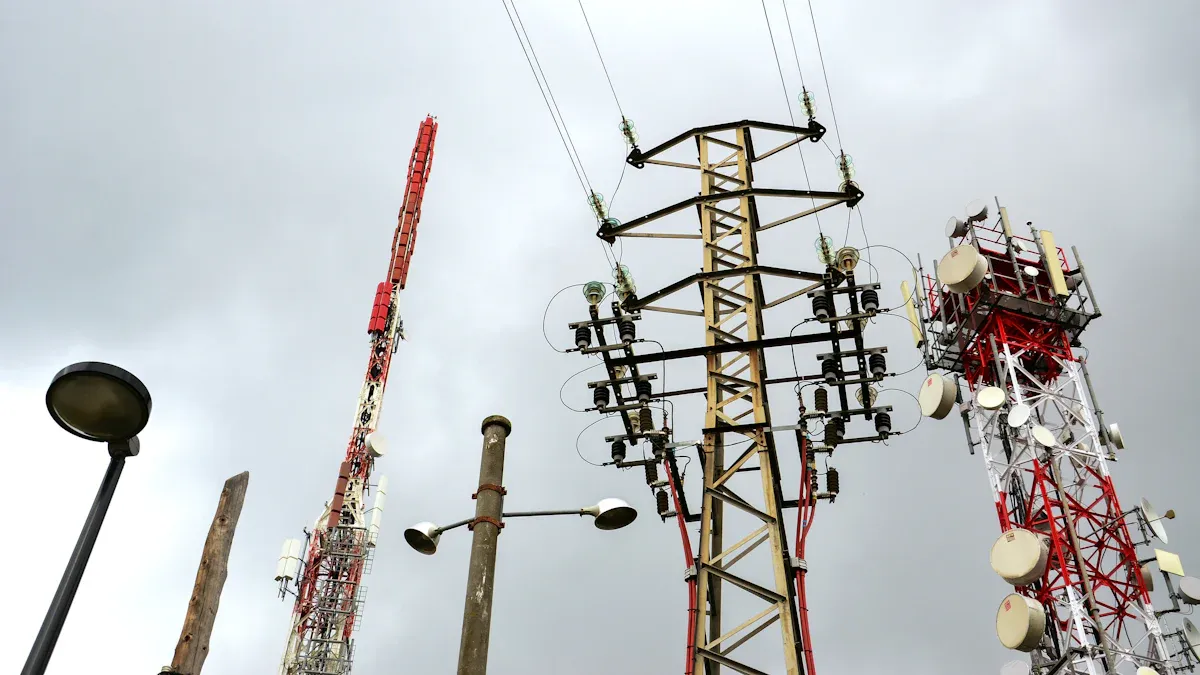What Are Rectifiers for Telecommunication Systems

Telecommunication systems require a steady DC power flow to function effectively. A rectifier for telecommunication converts AC power into DC power for telecom equipment, ensuring that the equipment operates smoothly without interruptions. Modern rectifiers, such as those from Alpine Power Systems, are highly efficient and safe. They can provide up to 50 Amps of DC power with low ripple, which protects sensitive equipment from power issues. These rectifiers comply with ISO and ITAR regulations, making them dependable for critical applications.
Key Takeaways
Rectifiers change AC power into DC power, which telecom tools need to work well.
New rectifiers use less energy and cost less, with some being over 95% efficient.
Good rectifiers keep telecom systems safe from power changes, giving steady power and less downtime.
Picking the right rectifier means knowing your power needs and matching it with your system.
Future rectifiers will be smarter and use green energy, helping telecom systems be eco-friendly and better.
What Is a Rectifier for Telecommunication?
Definition and Purpose
A rectifier for telecommunication changes alternating current (AC) into direct current (DC). This is important because most telecom equipment needs DC power to work. Without rectifiers, telecom systems would not run well. These devices give a steady power supply, keeping communication services running smoothly.
In the past, rectifiers were very simple. Early radios used crystal rectifiers to turn AC into DC for sound. Later, mechanical parts were replaced by semiconductor diodes. These made rectifiers more reliable and efficient. Today, rectifiers are crucial for powering things like satellites and wireless networks.
Why DC Power Is Essential in Telecom Systems
Telecom systems need DC power for several reasons. First, DC power gives stable voltage, which protects sensitive equipment. Power changes can cause problems or damage devices. Second, DC power works better for systems that run all the time, like data centers and cell towers.
Rectifiers help by turning AC from the power grid into DC. This powers satellites, wireless networks, and more. New technology has made rectifiers better, so telecom systems are now more reliable and efficient.
Key Features of Telecom Rectifiers
Modern telecom rectifiers have many useful features, such as:
High Efficiency: They save energy, with up to 98% efficiency. New designs cut power loss by 75%.
Reliability: Advanced rectifiers reduce downtime by 25%, keeping systems running.
Environmental Benefits: Some models lower carbon emissions by 40%, helping the planet.
Compatibility: They work well with backup systems like batteries and generators.
Feature | Metric |
|---|---|
Energy Savings | 30% less energy used |
Carbon Footprint Reduction | 40% fewer CO2 emissions |
Improved Reliability | 25% less downtime |
These features make rectifiers key to modern telecom systems. Picking the right rectifier improves efficiency, reliability, and helps the environment.
How Does a Rectifier Work in Telecommunication Systems?

The AC to DC Conversion Process
A rectifier changes alternating current (AC) into direct current (DC). This is important because telecom equipment needs DC power to work properly. AC flows back and forth, but rectifiers use diodes to make it flow in one direction. This turns AC into a bumpy DC current.
To make the current smooth, filters like capacitors or inductors are used. These filters create a steady DC power output. Engineers use tools like MATLAB to study how the current and voltage behave. They check important details like Average DC Voltage and RMS Output Current. This ensures the rectifier works well and meets telecom power needs.
Steps in the process include:
Rectification: Diodes stop reverse current, allowing one-way flow.
Filtering: Capacitors or inductors smooth out voltage bumps.
Regulation: Circuits keep voltage steady even if input changes.
Role in Powering Telecom Equipment
Telecom systems like cell towers and satellites need rectifiers for power. A rectifier gives the exact voltage and current needed for smooth operation. DC power is better for telecom because it reduces energy loss and protects devices from damage.
Studies show DC systems are popular in telecom because they save energy and are small. For example:
Almost half of new cell towers in 2024 will use advanced rectifiers, especially for 5G.
Remote areas prefer DC systems for their reliability.
By turning AC into DC, rectifiers help telecom equipment last longer. They also support faster internet and better mobile connections.
Integration with Backup Power Systems
Rectifiers work well with backup systems like batteries and generators. If the main power fails, the rectifier switches to backup without stopping the DC power. This is vital for telecom systems that must run all the time.
Modern rectifiers also work with solar panels. They turn the uneven DC power from solar panels into steady DC power for telecom use. This makes telecom systems more reliable and eco-friendly.
Benefits of backup integration include:
Uninterrupted Power: Keeps telecom running during outages.
Energy Savings: Balances power from the grid and backup.
Scalability: Allows adding solar power as networks grow.
Rectifiers are key to telecom power systems. They ensure stable and reliable power for communication networks.
Benefits of Using a Rectifier for Telecommunication
Energy Efficiency and Cost Savings
Rectifiers help telecom systems use less energy and save money. Modern rectifiers work very efficiently, often over 95%. This means they waste less energy when changing AC power to DC power. Lower energy waste leads to smaller electricity bills. Many rectifiers are modular, so you can add more parts as needed. This design keeps costs low while letting your system grow.
Model | Efficiency Rating | Cost Savings |
|---|---|---|
Model A | Over 95% | High |
Model B | Over 95% | High |
Rectifiers last a long time, so you don’t replace them often. Fewer replacements save money and help the environment. They lower the carbon footprint of telecom systems. As telecom moves toward greener solutions, efficient rectifiers help meet eco-friendly goals.
Enhanced Reliability and Stability
Telecom systems need steady power to work well. Rectifiers give stable DC power, which keeps equipment like cell towers running smoothly. They stop power problems that could cause shutdowns or downtime. This is very important for systems that must always work without interruptions.
Modern rectifiers can handle different power needs without breaking. Their smart designs lower the chance of failures. This keeps your telecom system working even in tough situations. Reliable rectifiers improve system performance and give you confidence in your network.
Protection Against Voltage Fluctuations
Voltage changes can harm telecom equipment and cost a lot to fix. Rectifiers keep the output voltage steady, even if input voltage changes. For example, Delta rectifiers handle input changes while giving stable DC power. This protects your equipment from damage.
Many rectifiers have safety features like overload protection and heat control. These features stop problems before they happen. Using rectifiers helps protect your telecom system and makes equipment last longer. This reduces risks and saves money over time.
Picking the Best Rectifier for Telecom Systems
Understanding Power and Voltage Needs
To choose a rectifier, know your power and voltage needs. First, figure out how much power your telecom devices use. Add up the wattage of all equipment that will use the rectifier. This makes sure the rectifier can handle the load without problems. Next, check your system's voltage needs. Most telecom systems use DC voltages like 48V, but confirm this to avoid issues.
Think about future growth too. If you plan to expand, pick a rectifier with more power capacity. This avoids frequent upgrades later. Tools like power calculators can help you estimate power needs easily.
Matching with Current Equipment
Your rectifier should work well with your existing setup. Check if it matches your power source, like the grid, solar panels, or generators. A mismatch can cause problems or failures. Look for rectifiers that work with your current battery systems. Many modern rectifiers let you add or replace parts without stopping operations.
Also, check the size of the rectifier. Make sure it fits in your racks or enclosures. Smaller designs are better for tight spaces. Good compatibility makes installation faster and ensures smooth operation.
Checking Efficiency and Strength
Efficiency and strength are important when picking a rectifier. Efficient models turn more AC power into DC power, saving energy. Look for rectifiers with efficiency ratings over 95%. These save money and reduce energy waste.
Strength matters too. Telecom systems often face tough conditions like heat, humidity, and dust. The rectifier should handle these challenges. Look for certifications like IP ratings or industry standards. These show the rectifier can work reliably for a long time. Choosing a strong and efficient rectifier lowers maintenance and keeps your system running well.
Future Trends in Rectifier Technology

Improvements in Energy Efficiency
Rectifiers are using less energy and saving more power. New designs focus on better power conversion and less energy waste. For example, three-level PWM rectifiers now work smarter. They improve power use and cut down on energy problems. These changes make sure more input power turns into useful output power.
Metric | Meaning |
|---|---|
Power Factor | Shows how well electrical energy is used. |
Harmonic Pollution | Measures energy problems like Total Harmonic Distortion (THD). |
Efficiency | Tells how much input power becomes output power. |
The rectifier market is growing fast. It was worth $7 billion in 2023 and may reach $10.5 billion by 2035. This growth shows the need for energy-saving solutions in telecom systems.
Using Renewable Energy Sources
Telecom rectifiers now work with renewable energy like solar power. This helps save energy and use fewer traditional power grids. Rectifiers can turn uneven DC power from solar panels into steady DC power. A typical setup might include:
Feature | Meaning |
|---|---|
Solar Panel Output | 2976 kWh/year |
Battery Capacity | 1250 kWh |
Max Discharge Output | 286.1 kW |
Battery Lifetime | 20 years or 6,250,000 kWh |
Energy Storage | Saves extra power for later use, like at night. |
This setup gives steady power and supports eco-friendly telecom systems. As solar energy grows, rectifiers will help balance power needs.
Smart Rectifiers and IoT Features
Smart rectifiers with IoT features are changing telecom power systems. These devices check and adjust power in real time. This makes them more reliable and efficient. For example, the U.S. Department of Energy spent $3 billion on smart grid tools, including advanced rectifiers. These systems talk to other devices, helping fix problems early and avoid downtime.
The semiconductor rectifier market is also growing. Companies like Valeo and ROHM Semiconductor are making better power tools for electric motors. Smart rectifiers improve telecom systems by saving money, boosting performance, and preparing for future tech.
Rectifiers are important for powering telecommunication systems. They give steady DC power, helping equipment work smoothly without stopping. This leads to saving energy, better reliability, and safety from voltage problems.
💡 Future Insight: New ideas like smart rectifiers and using renewable energy will change telecom systems. These updates will make networks greener, smarter, and more efficient.
Picking the best rectifier improves your network and gets it ready for future technology needs.
FAQ
What is the lifespan of a telecom rectifier?
Most telecom rectifiers work for 10 to 15 years. Taking care of them can make them last longer. Cleaning and checking them often helps keep them working well. Strong models with good parts may last even more years.
Can a rectifier handle power surges?
Yes, modern rectifiers protect against power surges. They have features like overload protection and voltage control. These keep your telecom equipment safe from sudden electrical spikes.
How do I know if my rectifier is energy-efficient?
Look at the efficiency rating of your rectifier. If it’s over 95%, it saves energy well. Certifications or labels can show energy-saving features. These help lower power waste and cut electricity costs.
Are rectifiers compatible with renewable energy sources?
Yes, many rectifiers work with solar panels and other green energy systems. They turn uneven DC power into steady DC power. This makes them great for eco-friendly telecom setups.
What maintenance does a rectifier require?
Keep your rectifier clean and check its parts often. Look at filters and cooling systems to make sure air flows well. Follow the maker’s rules to keep it working smoothly. This stops problems and keeps it running longer.
💡 Tip: Plan regular checkups to avoid issues and extend your rectifier's life.
See Also
Understanding The Use Of -48VDC In Telecom Cabinets
Methods For Calculating Power Systems In Telecom Cabinets
Essential Features Of Power Supplies In Telecom Systems
Ensuring Consistent Power Supply For Telecom Cabinets
Integrating Solar Inverters And Batteries In Telecom Solutions
CALL US DIRECTLY
86-13752765943
3A-8, SHUIWAN 1979 SQUARE (PHASE II), NO.111, TAIZI ROAD,SHUIWAN COMMUNITY, ZHAOSHANG STREET, NANSHAN DISTRICT, SHENZHEN, GUANGDONG, CHINA

